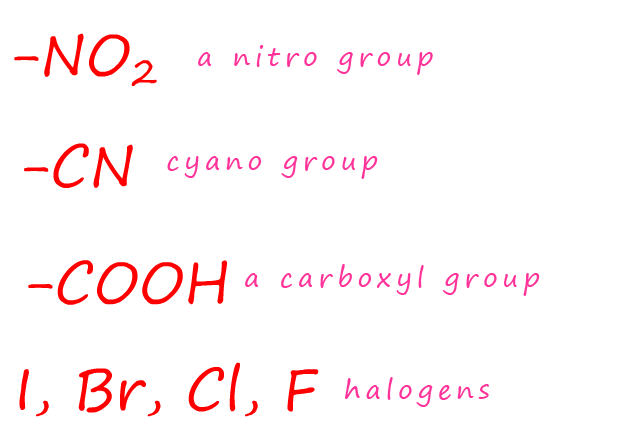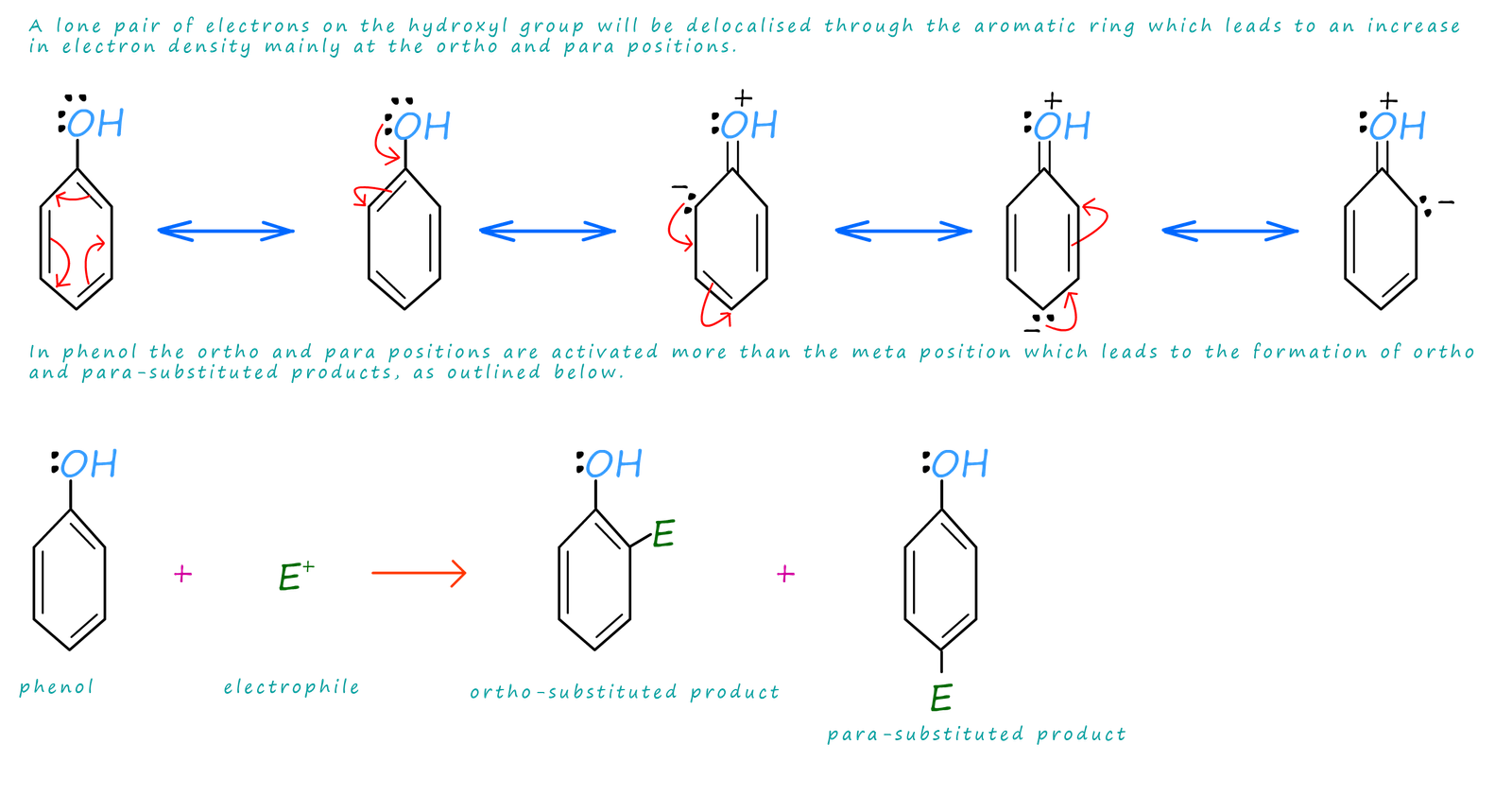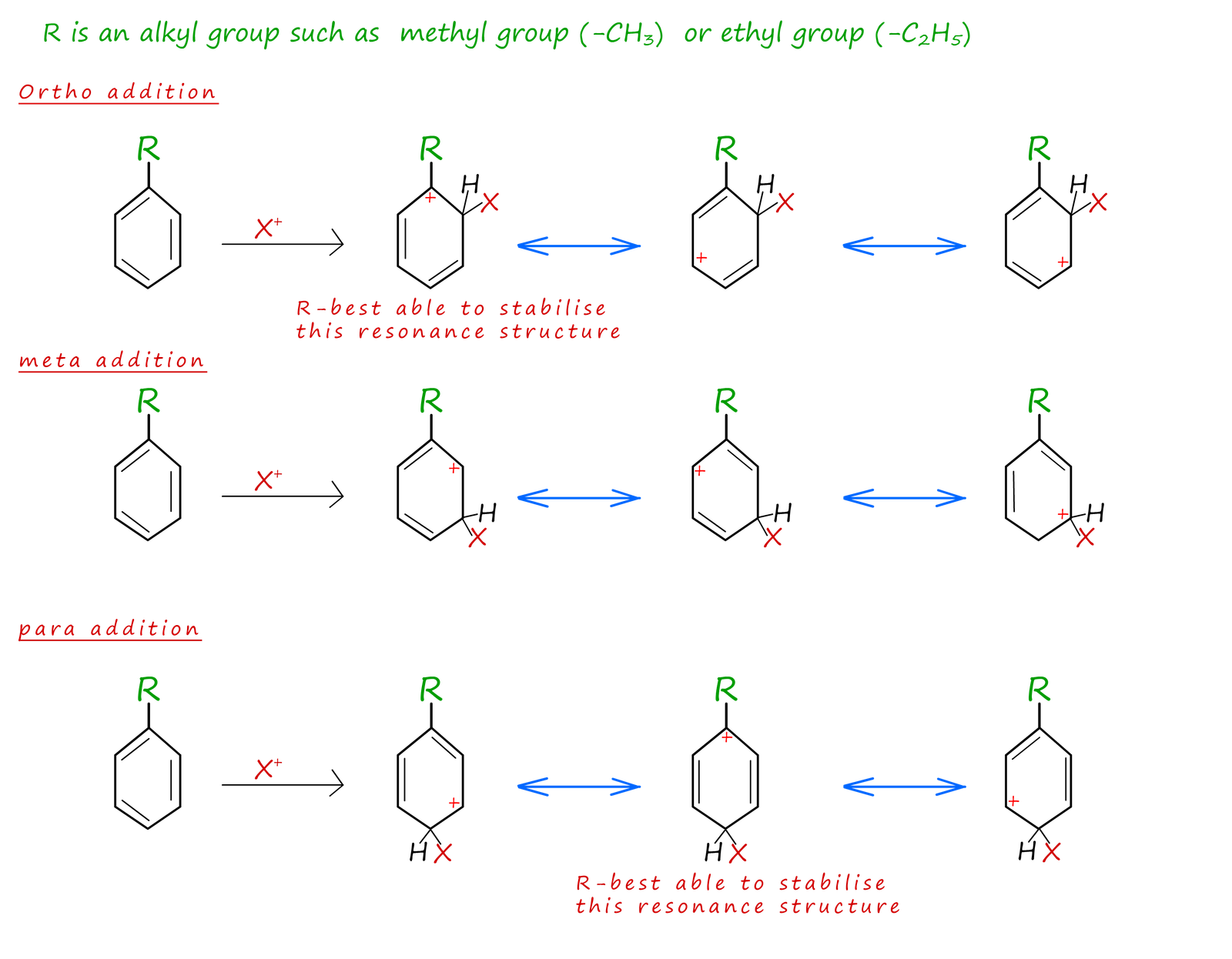

As you already know aromatic rings undergoes electrophilic substitution reactions where one of the hydrogen atoms
in the aromatic ring can be replaced by another substituent to form a monosubstituted aromatic ring. In this reaction the
delocalised
pi(π) electrons in the aromatic ring attack an
electrophile. On this page we will discuss what
happens when we try to add another electrophile to a
monosubstituted aromatic ring to form
a disubstituted aromatic ring and discuss how an any added substituent affects the overall reactivity of an aromatic ring.
The presence of a substituent already on an aromatic ring can affect the reactivity of the
aromatic ring
in two ways:

The placement of a second substituent (Y) onto the aromatic ring is largely influenced by the substituent (X) already on the ring. The second substituent can be directed to:
or
or
If a monosubstituted aromatic ring
is less reactive towards electrophilic substitution then it
is described as being a deactivated ring but if it is more
reactive than benzene then the substituted aromatic ring has
been activated by the attached substituent.
The table below shows a few substituents that will activate and
also deactivate an aromatic ring.
A feature of all substituents or groups that activate an
aromatic ring is that they are electron
donors and they will increase
the electron density in the aromatic ring
whereas all substituents or groups that deactivate the ring
are electron withdrawing
groups and they decrease the electron density in the
aromatic ring.
| Activating groups | Deactivating groups |
 |
 |
If a substituent (X) is chemically bonded to an aromatic ring; as shown in the diagram below and it withdraws electron density from the aromatic ring then its ability to act as a nucleophile and attack an electrophile (E+) will be greatly reduced. In this case we would say that the aromatic ring is less reactive than benzene to electrophilic substitution, that is it has been deactivated.

However if the substituent attached to the aromatic ring is an electron donor and it increases the electron density in the aromatic ring then the aromatic ring will be more reactive than benzene to electrophilic substitution. That is the ring has been activated.
If the substituent on the aromatic ring increases electron density in the ring then this will also help to stabilise the intermediate cation formed during the electrophilic substitution reaction. Whereas if the substituent withdraws electron density from the aromatic ring then this will destabilise the intermediate cation formed, this will result in any further electrophilic substitution reactions being less likely as more energy will be needed to form the intermediate cation.
As we have seen substituents can activate or deactivate an aromatic ring by releasing or withdrawing electron density from the ring in two unique ways:
Resonance effects operate by overlapping of the delocalised pi(π) electrons in the aromatic ring with electron in p-orbitals on the attached substituent. Substituent such as the amine group (-NH2) increase electron density due to the fact that the lone pair electrons on the nitrogen atom are in 2p-orbitals which can be delocalised through an aromatic ring. Other substituents such as the nitro group (-NO2) and the cyano group (-CN) remove electron density from the ring by delocalising the aromatic pi(π) electrons though the nitro and cyano groups, which ultimately decreases electron density in the aromatic ring.
Inductive effects are mainly due to simple differences in the electronegativity or dipoles of any attached substituent or groups on the aromatic ring. Halogen atoms (F, Cl, Br) attached to an aromatic ring withdraw electron density from the aromatic ring simply because they are more electronegative than the carbon atoms in the aromatic ring. Nitro, carbonyl and cyano groups not only withdraw electron density due to resonance effects but also because of the dipoles of these groups, the atom in these groups which is attached directly to the aromatic ring will have a partial negative charge and this will result in a shift of electron density from the aromatic ring towards the attached group, this is outlined in the image below:

You maybe wondering why groups such as the amine group (-NH2) and the hydroxyl group (-OH)
which are listed as activating the
aromatic ring in the table above are
activating groups at all, since in each of these groups
the atom attached to the aromatic ring, that is a
nitrogen and an
oxygen atom are both very electronegative
elements and therefore you might expect these groups to deactivate
the ring by withdrawing electron density from it, however
there is also a resonance effect present in both these
groups which pushes electron density back into the ring and
this significantly
overcomes the electron withdrawing
inductive effects.
The diagram below shows how the amine group can
push electron density into the
aromatic ring and increase its electron density, particularly at the ortho
and para positions. This means that in practice any electrophile is likely to add to positions 2 and 4, that
is the ortho and para positions.


Alkyl groups such as methyl (-CH3) and ethyl (-C2H5) will also activate aromatic rings. This is another example of an inductive effect by an attached group on the aromatic ring, but this time the alkyl groups push electron density into the ring and activate it. As an example consider toluene (methylbenzene) which is approximately 15 times more reactive than benzene towards electrophilic substitution.
As mentioned above aromatic rings can be
activated to undergo electrophilic substitution more readily by
resonance and
inductive effects. The amino group (-NH2) and the hydroxyl group (-OH) are two such groups
which will increase electron density in an
aromatic ring by "feeding or pushing in" electrons
from the lone pairs
on either the nitrogen and oxygen
atoms attached directly to the aromatic ring. As an example
consider hydroxybenzene or phenol (C6H5OH),
shown in the image below.
The increase in electron density within the
ring leads to the formation of a number of resonance
structures, as shown below. What is interesting to note here is that
electron donating properties of the amino and hydroxyl
groups leads to an increase in electron density
at the ortho and para positions more that at the meta position. This means that an
electrophile is more likely to be attracted to these
activated positions and so will lead to the formation
of substituents being added mainly to the ortho and para positions.

Alkyl substituted aromatic rings are also activated but as mentioned earlier these aromatic compounds are activated by the inductive effects of the alkyl substituent. However as in the case above further electrophilic substitution reactions of alky substituted aromatic rings tend to occur at the ortho and para positions. This is mainly due to the ability of the alkyl substituent to help stabilise the intermediate carbocations formed during the electrophilic substitution reaction most effectively at the ortho and para positions. This means that these carbocations will require less energy to form and will therefore have more of a presence in the overall resonance hybrid structure (recall that the actual structure of the intermediate carbocation is a combination or hybrid of all the intermediate resonance structures and if one intermediate structure is lower in energy it will have more of an input into the structure of the final resonance hybrid structure). This is outlined in the diagram below:

Any group which deactivates the
aromatic ring by withdrawing electron density
will form similar resonance
structures for the intermediate carbocation that results from the addition of an
electrophile to the aromatic
ring that we saw above. In the example below benzoic acid, which is essentially an
aromatic ring with an electron
withdrawing carboxyl group attached. The carboxyl group
will withdraw electron density from the
aromatic ring and as such will deactivate all the positions
in the aromatic ring.
However
from the resonance structures drawn below you can see
that with the ortho and para positions on the substituted aromatic ring
we have the very unfavourable case of a carbon atom with a positive charge in the ring next to a δ+
carbon atom in the carbonyl group. This situation does not result when the substituent X
adds to the meta position. This
means that the resonance
structure for the meta position will be more favourable, that is lower in
energy
and so is more likely to form. This essentially means that addition of an
electrophile to a deactivated
aromatic ring is more likely to occur at the meta position that
at the ortho and para positions. The major
product of any electrophilic substitution reaction here will be the one where the electrophile adds to the meta
position.
